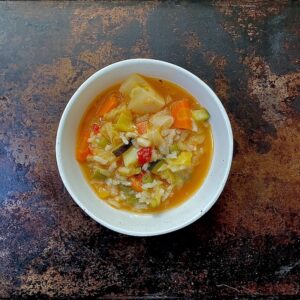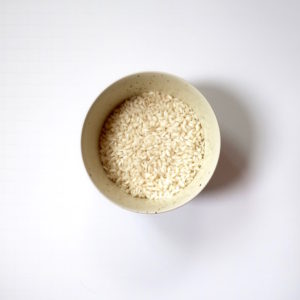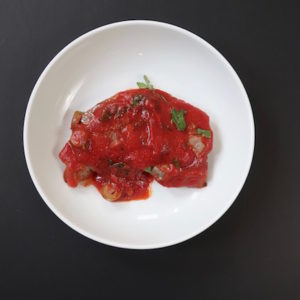Pesto
Pesto may have become more popular than is good for it.
Marcella Hazan, Essentials of Classic Italian Cooking
A few years ago my husband offered to plant some kitchen herbs for me. “What would you like?” he asked.
“Basil?” I responded tentatively.
Three years later, the basil plants are merrily shoving the tomatoes aside, ignoring the cilantro, and rolling over our attempts to cultivate chives.

Many are the cookbooks suggesting people like us freeze our basil gluts in ice cube trays. Then, come the winter months, or what passes for them these days, we’ll feast on pesto in January.

Yes, that’s parsley in there.
I never do this, and never will. For me, basil, processed into its close friend pesto, accompanies summer dishes like corn, squash, chicken, and best of all, tomatoes in all their glory. It is not winter food.

Not a tomato. Check back in a few weeks.
—
I confess my pestos are ad hoc affairs, assembled by eye, hand, and taste. This makes composing a recipe challenging, if not impossible.
The novice pesto maker is well advised to know that pesto is all about basil. The remaining ingredients–parmesan cheese, garlic, salt, pine nuts, olive oil, butter–play supporting roles.

True Genoese pesto is made with pine nuts, and before food prices rivaled mortgage payments, I prepared it that way. No longer.
 No nuts. Olive oil.
No nuts. Olive oil.
This said, if nutless pesto appals you, walnuts make an admirable understudy. I’d avoid hazelnuts or peanuts, as their flavors are too strong here.
Unlike Skordalia or ailoi, Pesto isn’t a vehicle for garlic. Marcella Hazan’s pesto recipes, in Marcella Says and Essentials of Classic Italian Cooking, suggest an abstemious two cloves. Elizabeth David, no miser where garlic is concerned, suggests “one or two cloves” in her pesto recipe, which appears in both Summer Cooking and Italian Food. Having said this, pesto does contain raw garlic, which makes itself known, just not in the overarching manner of a grand aioli.

True pesto calls for Parmigiano-Romano cheese. This ambrosial stuff was expensive before the pandemic. Now it is, to borrow a wonderful English expression, eye-wateringly expensive. Like all artisanal foods, Parmigiano-Romano is worth the price.

Unrelated photo of baby onions.
Should Parmigiano-Romano be out of your reach, I suggest purchasing the best Parmesan you can. In my case, this means a mixture of American and Italian Parmesans. I confess the American Parmesan is pre-ground by my market. But my market is Berkeley Bowl, and I have severe carpal tunnel syndrome.

I buy the Italian parmesan in wedges. Rather than grate it–see above–I use a vegetable peeler to shave off the amounts needed. Don’t sniff. It works.

Pesto is traditionally made with a mortar and pestle. See severe carpal tunnel, two paragraphs up, for why I use a mini-processor. Lacking either of these, pesto may be made using a sharp knife, a mezzaluna and a deep bowl, or a blender.

Yes, that is parsley. It was use it or let it spoil.
However you decide to make your pesto, it will keep for weeks, provided it is in an immaculate container and covered with an air-excluding layer of olive oil.

To serve pesto, remove it from the refrigerator about ten minutes before eating. Dip a clean utensil into the container. Serve. Return for additional helpings, always using a clean spoon.

Pesto on toasts with mushroom salad, eaten last week.
Pesto
yield: about 1 cup/227 grams
Prep time: 10 minutes
As discussed in the post, the amounts given below are approximate. Please taste as you go, remembering Parmesan is quite salty and garlic grows stronger as it sits.
If you are making pesto with a processor, mind the blades.
Please see notes, below, before starting to cook.
1 large bunch fresh basil leaves, or 2 lightly packed cups/approx 40 grams
1 large garlic clove, peeled and halved
2-4 tablespoons best Parmesan cheese, grated or shaved off using vegetable peeler
Bottle of olive oil: the pesto needs around 1/4 cup/60ml-1/2 cup/120ml
teaspoon salt
2 tablespoons pinenuts or walnuts (optional; I didn’t use them in my recipe)
a squeeze of lemon juice (optional)
You will need a small food processor, blender, mortar and pestle, mezzaluna and bowl, or sharp knife and large cutting board to make pesto.
You will also need a medium-sized bowl, a spatula, and a spoon.
I use a small food processor, and begin by loading the processor bowl with half the garlic clove, half the basil leaves, a pinch of salt, and a good pour of olive oil–about three tablespoons. You want to be generous with the olive oil here. Hit the processor’s “high” button and process for about 30 seconds. The ingredients should begin coming together.
Stop the machine, remove the top, and have a look. The ingredients should appear amalgamated and moist. Like pesto, in fact. If the basil appears dry and flaky, add more olive oil and process a little more. If you see pesto, add more basil, cheese, and olive oil and keep going.
If you think the processor bowl is getting too full, you can spoon some pesto out into the waiting bowl.
Whatever the case, keep going, blending the ingredients in the processor (or however you are making the pesto), tasting continuously for cheese, salt, and texture. The cheese should feature without taking over, and the texture should be pleasantly nubbly.
Once the pesto is blended, use the spoon and spatula to transfer it into the bowl. Stir it well, tasting again. If you aren’t serving it immediately, film the top with olive oil and refrigerate.
To serve the pesto, remove it from the refrigerator about ten minutes before eating. Remove the amount desired with a clean spoon. When you are finished, cover with the remaining pesto with fresh olive oil and refrigerate. The pesto will keep, refrigerated, 3-4 weeks.
Pesto may be eaten with pasta, chicken, pork, in sandwiches or on pizza. Richard Olney gives a sensuous, evocative description of eating pesto-filled tomatoes at Lulu Peyraud’s Domain (with her husband, Lucein Peyraud, she ran Domaine Tempier Winery). The recipe, Plum Tomatoes with Basil, appears in Lulu’s Provencal Table.
Notes:
As mentioned in the post, using a vegetable peeler to shave curls off cheese is easier on my hands than grating. Do whatever you prefer.
Rather than dictate an arbitrary amount of olive oil, I’d rather be honest and admit I pour as I go. If you’re worried about overdoing it, cover the bottle with a finger or pour some olive oil into a measuring cup.
Pine nuts are traditionally used in pesto, and they’re wonderful. They’re also very expensive. Add two tablespoons, or more, if you wish. Walnuts make a good substitute.
Lemon juice is not a traditional pesto ingredient. Further, it fades pesto’s lovely deep green. But if your pesto is lackluster, lemon juice might save it. Try it on a small amount of pesto first.
Cleaning tip: old toothbrushes make excellent cleaning tools, especially for food processor blades. Baking soda mixed with white vinegar is a cheap, effective cleaning solution for greasy blades and processor bowls.




